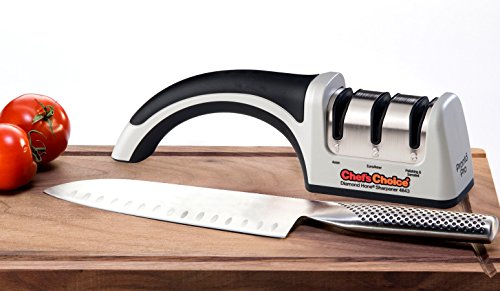You like to cook. At some point your knives are becoming dull. If you don’t want to continue working with dull knives, you need a sharping tool.
There exist thousands of sharpening tools out there with two of them being:

Grinding Stone

Electric Knife Sharpener
Let’s compare those two in a couple of categories.
Grinding Stone
-
Simplicity: It’s a stone. I don’t think it gets any simpler than that. The word repair does not even make sense for it.
-
Ease-of-use: Sharping takes some skill.
-
Multi-purpose: You can sharpen whatever you want.
Electric Knife Sharpener
-
Simplicity: A complex electric device with multiple moving parts. Its development required thousands of years of civilization.
-
Ease-of-use: Reading a manual and pushing a button. That’s doable.
-
Multi-purpose: It does sharpen knives apparently. What about scissors?
Comparison
If you are an attentive reader then you already got a feeling which tool I would chose: the sharpening stone. Let’s take a closer look at the before mentioned categories again.
Why is being simple so important? First, less things can break. This greatly enhances the life-time of a product as well as repair possibilities. A tool should have the least amount of moving parts. Each joint will fail at some point, no matter what. Complex electronics are even worse. They are very hard to repair and require specialized equipment.
A very good indicator of durability is the second-hand retail value. If a tool has a great retail value even after heavy-use that’s a good indicator. Therefore, check things like ebay Kleinanzeigen, at least if you are buying in Germany.
Another question I am usually asking myself: Is there a simpler tool which relies more on my skills than on some (electronic) mechanism? Good, I choose this one. Think hard if the additional functionality or ease-of-use is worth the complexity introduced. Instead of relying on the tool or the ingenuity of its inventor, I advocate for investing time in your own skills. Learn how to use a simple sharpening stone. This is especially worthwhile for tasks that you will do for your entire life. Like sharpening knives hopefully.
Another upside of the skill-based approach is its flexibility: if you find yourself suddenly out somewhere and in the need of sharpening some object, it is very likely that you can get the job done. You can sharpen on many coarse objects like the back of a ceramic plate and you will have the necessary experience to guide you along. In comparison, being able to push a button will not bring you very far.
Sometimes going for simpler tools means less perfect results. In my opinion perfectionism is killing the do-it-yourself spirit. DIY is about getting things done with a finite and reasonable invest in terms of time and money. The result should never be an industrial perfect result. That’s part of the fun!
Common Pitfalls
Battery Power
Battery-powered devices can make sense but only if you are a power user. You are going to use the tool so intensively in the next three years that other things will break before the battery? Then it might make sense to benefit from the additional portability. Otherwise, I’d say no.
Ultra Light
In recent years, there is the trend to make everything ultra-light. A reduction in weight is always a trade-off. And in most cases durability is traded in.
For example: Any type of fabric which is made thinner will always result in less durability. This is just a fact. Also, prices increase very steeply for miniscule weight reductions. And I am pretty sure that your body will not notice 10 grams difference. So be attentive when ultra-light is advertised and consider the drawbacks.
Conclusion
Having a universal, high quality set of tools on your side to handle life is a great source of satisfaction for me. I am always happy when I can use them and just get stuff done.